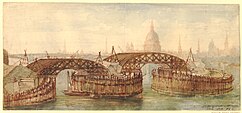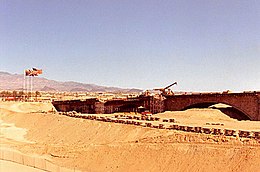👀💥😏😜💋👉
New London Bridge (1831–1967)
In 1799, a competition was opened to design a replacement for the medieval bridge. Entrants included Thomas Telford; he proposed a single iron arch span of 600 feet (180 m), with 65 feet (20 m) center clearance beneath it for masted river traffic. His design was accepted as safe and practicable, following expert testimony. Preliminary surveys and works were begun, but Telford's design required exceptionally wide approaches and the extensive use of multiple, steeply inclined planes, which would have required the purchase and demolition of valuable adjacent properties.
A more conventional design of five stone arches, by John Rennie, was chosen instead. It was built 100 feet (30 m) west (upstream) of the original site by Jolliffe and Banks of Merstham, Surrey,[38] under the supervision of Rennie's son. Work began in 1824 and the foundation stone was laid, in the southern coffer dam, on 15 June 1825.
The old bridge continued in use while the new bridge was being built, and was demolished after the latter opened in 1831. New approach roads had to be built, which cost three times as much as the bridge itself. The total costs, around £2.5 million (£242 million in 2021), were shared by the British Government and the Corporation of London.
Rennie's bridge was 928 feet (283 m) long and 49 feet (15 m) wide, constructed from Haytor granite. The official opening took place on 1 August 1831; King William IV and Queen Adelaide attended a banquet in a pavilion erected on the bridge. The northern approach road, King William Street, was renamed after the monarch.
In 1896 the bridge was the busiest point in London, and one of its most congested; 8,000 pedestrians and 900 vehicles crossed every hour.[20] It was widened by 13 feet (4.0 m), using granite corbels. Subsequent surveys showed that the bridge was sinking an inch (about 2.5 cm) every eight years, and by 1924 the east side had sunk some three to four inches (about 9 cm) lower than the west side. The bridge would have to be removed and replaced.
Sale to Robert McCulloch
Common Council of the City of London member Ivan Luckin put forward the idea of selling the bridge, and recalled: "They all thought I was completely crazy when I suggested we should sell London Bridge when it needed replacing." Subsequently, in 1968, Council placed the bridge on the market and began to look for potential buyers. On 18 April 1968, Rennie's bridge was purchased by the Missourian entrepreneur Robert P. McCulloch of McCulloch Oil for US$2,460,000. The claim that McCulloch believed mistakenly that he was buying the more impressive Tower Bridge was denied by Luckin in a newspaper interview] Before the bridge was taken apart, each granite facing block was marked for later reassembly.
The blocks were taken to Merrivale Quarry at Princetown in Devon, where 15 to 20 cm (6 to 8 inches) were sliced off the inner faces of many, to facilitate their fixing. (Stones left behind were sold in an online auction when the quarry was abandoned and flooded in 2003) 10,000 tons of granite blocks were shipped via the Panama Canal to California, then trucked from Long Beach to Arizona. They were used to face a new, purpose-built hollow core steel-reinforced concrete structure, ensuring the bridge would support the weight of modern traffic. The bridge was reconstructed by Sundt Construction at Lake Havasu City, Arizona, and was re-dedicated on 10 October 1971 in a ceremony attended by London’s Lord Mayor and celebrities. The bridge carries the McCulloch Boulevard and spans the Bridgewater Channel, an artificial, navigable waterway that leads from the Uptown area of Lake Havasu City.










No comments:
Post a Comment